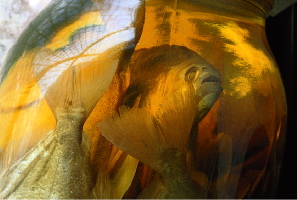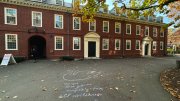Editor's note: Purcell grew up in Cambridge and was taken often to the Museum of Comparative Zoology. "I stood mute, appalled, at the age of six, seven, and eight below the huge teeth and dark throat of a brutish hippo," she reports. "Each time I saw the hippo I said nothing. I just thought the exhibits were dead animals, corpses as scenery, erected to scare cowards like me." She began photographing the collections of the MCZ in the early 1980s. "While I lacked all affection for dead animals," she says, "I believed that if I wanted to be an artist, I had to contemplate subjects I didn't necessarily want to see."
 |
| Piranhas collected on a Brazilian expedition that Louis Agassiz led in 1865-66. He took six students, one of them William James. |
| Comment and photograph by Rosamond Wolff Purcell |
Within months I was riffling through stacks of dried primate, bat, and flying-squirrel skins as though I'd been handling the smelly flats professionally for years. I lost myself in corridors and byways, in aisle after aisle of vipers, wolves, rats, and eggs. The MCZ houses turtles, snakes, toads, fishes, butterflies, beetles, fossil shrimps and mastodons, lions, tigers, armadillos, rabbits, and more than 330,000 birds. Although I have since explored the back rooms in a number of museums, I am particularly attached to this place.
Through the viewfinder, I often find splendor in modest specimens. I place a trilobite-like fossil against weather-stained copper to visually separate the specimen from the institution. The head-shield of the fossil, like a New England gravestone angel against a blurred green shower of leaves, with sun pouring across its surface, is now no longer just one in a million.
This quest to translate natural objects into changelings can seem, I suppose, both trivial and disconcerting to any keeper whose mandate is, in no small part, to safeguard the collection against the scientifically ignorant public--including, of course, most artists. "Like an iceberg, the Museum presents only a small portion of itself to public view," state the authors of the booklet About the Exhibits, offered for sale to visitors. Millions of specimens are behind the showcase hallways, stored in a maze of storerooms, cupboards, closets, vaults. Not much has changed over the last 140 years. There are ledgers in each department of the museum with entries, in English and Latin, of all the specimens. Over time the handwriting in these books has evolved from copperplate to the Palmer Method to a late-twentieth-century, vaguely roman, hand. The names of the animals are also printed in mostly faded fonts on the outside of the storage doors: leporidae, dasidorpidae, cervidae, pinididae, to keep us on the proper Linnaean track. Little by little, the data are transferred to computers.
Somewhere between the gathering in of the animal and the research on it falls the shadow of culture, of language, and of the ledger. "The tag without the specimen has real value, but a specimen without its tag is worthless," scolded a collections manager at Harvard upon finding that I had, just for a moment--long ago--separated one from the other. I had done so to overcome the particularity of the labels, which seemed to short-circuit the illusions that the brittle armadillos, sodden sloths, or muscular vipers evoke when set in a patch of sunlight on a golden afternoon.





